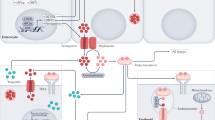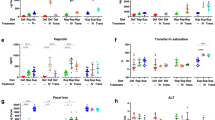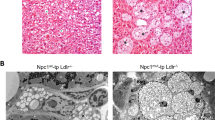Abstract
The composition of the gut microbiota is affected by environmental factors as well as host genetics. Iron is one of the important elements essential for bacterial growth, thus we hypothesized that changes in host iron homeostasis, may affect the luminal iron content of the gut and thereby the composition of intestinal bacteria. The iron regulatory protein 2 (Irp2) and one of the genes mutated in hereditary hemochromatosis Hfe , are both proteins involved in the regulation of systemic iron homeostasis. To test our hypothesis, fecal metal content and a selected spectrum of the fecal microbiota were analyzed from Hfe−/−, Irp2−/− and their wild type control mice. Elevated levels of iron as well as other minerals in feces of Irp2−/− mice compared to wild type and Hfe−/− mice were observed. Interestingly significant variation in the general fecal-bacterial population-patterns was observed between Irp2−/− and Hfe−/− mice. Furthermore the relative abundance of five species, mainly lactic acid bacteria, was significantly different among the mouse lines. Lactobacillus (L.) murinus and L. intestinalis were highly abundant in Irp2−/− mice, Enterococcus faecium species cluster and a species most similar to Olsenella were highly abundant in Hfe-/- mice and L. johnsonii was highly abundant in the wild type mice. These results suggest that deletion of iron metabolism genes in the mouse host affects the composition of its intestinal bacteria. Further studying the relationship between gut microbiota and genetic mutations affecting systemic iron metabolism in human should lead to clinical implications.




Similar content being viewed by others
References
Andrews SC, Robinson AK, Rodriguez-Quinones F (2003) Bacterial iron homeostasis. FEMS Microbiol Rev 27(2–3):215–237
Ashida H, Ogawa M, Kim M, Mimuro H, Sasakawa C (2011) Bacteria and host interactions in the gut epithelial barrier. Nat Chem Biol 8(1):36–45
Babitt JL, Lin HY (2011) The molecular pathogenesis of hereditary hemochromatosis. Semin Liver Dis 31(3):280–292
Bailey JR, Probert CS, Cogan TA (2011) Identification and characterisation of an iron-responsive candidate probiotic. PLoS One 6(10):e26507
Barbas AS, Lesher AP, Thomas AD, Wyse A, Devalapalli AP, Lee YH, Tan HE, Orndorff PE, Bollinger RR, Parker W (2009) Altering and assessing persistence of genetically modified E. coli MG1655 in the large bowel. Exp Biol Med (Maywood) 234(10):1174–1185
Beasley FC, Marolda CL, Cheung J, Buac S, Heinrichs DE (2011) Staphylococcus aureus transporters Hts, Sir, and Sst capture iron liberated from human transferrin by Staphyloferrin A, Staphyloferrin B, and catecholamine stress hormones, respectively, and contribute to virulence. Infect Immun 79(6):2345–2355
Behrenfeld MJ, Worthington K, Sherrell RM, Chavez FP, Strutton P, McPhaden M, Shea DM (2006) Controls on tropical Pacific Ocean productivity revealed through nutrient stress diagnostics. Nature 442(7106):1025–1028
Benoni G, Cuzzolin L, Zambreri D, Donini M, Del Soldato P, Caramazza I (1993) Gastrointestinal effects of single and repeated doses of ferrous sulphate in rats. Pharmacol Res 27(1):73–80
Benson AK, Kelly SA, Legge R, Ma F, Low SJ, Kim J, Zhang M, Oh PL, Nehrenberg D, Hua K, Kachman SD, Moriyama EN, Walter J, Peterson DA, Pomp D (2010) Individuality in gut microbiota composition is a complex polygenic trait shaped by multiple environmental and host genetic factors. Proc Natl Acad Sci USA 107(44):18933–18938
Bikandi J, San Millan R, Rementeria A, Garaizar J (2004) In silico analysis of complete bacterial genomes: PCR, AFLP-PCR and endonuclease restriction. Bioinformatics 20(5):798–799
Blaut M (2002) Relationship of prebiotics and food to intestinal microflora. Eur J Nutr 41(Suppl 1):I11–I16
Braun V, Hantke K (2011) Recent insights into iron import by bacteria. Curr Opin Chem Biol 15(2):328–334
Brissot P, Bardou-Jacquet E, Troadec MB, Mosser A, Island ML, Detivaud L, Loreal O, Jouanolle AM (2010) Molecular diagnosis of genetic iron-overload disorders. Expert Rev Mol Diagn 10(6):755–763
Bruyneel B, Vandewoestyne M, Verstraete W (1989) Lactic-acid bacteria: microorganisms able to grow in the absence of available iron and copper. Biotechnol Lett 11:401–406
Buhnik-Rosenblau K, Danin-Poleg Y, Kashi Y (2011) Predominant effect of host genetics on levels of Lactobacillus johnsonii bacteria in the mouse gut. Appl Environ Microbiol 77(18):6531–6538
Camaschella C, Poggiali E (2011) Inherited disorders of iron metabolism. Curr Opin Pediatr 23(1):14–20
Coale KH, Johnson KS, Chavez FP, Buesseler KO, Barber RT, Brzezinski MA, Cochlan WP, Millero FJ, Falkowski PG, Bauer JE, Wanninkhof RH, Kudela RM, Altabet MA, Hales BE, Takahashi T, Landry MR, Bidigare RR, Wang X, Chase Z, Strutton PG, Friederich GE, Gorbunov MY, Lance VP, Hilting AK, Hiscock MR, Demarest M, Hiscock WT, Sullivan KF, Tanner SJ, Gordon RM, Hunter CN, Elrod VA, Fitzwater SE, Jones JL, Tozzi S, Koblizek M, Roberts AE, Herndon J, Brewster J, Ladizinsky N, Smith G, Cooper D, Timothy D, Brown SL, Selph KE, Sheridan CC, Twining BS, Johnson ZI (2004) Southern Ocean iron enrichment experiment: carbon cycling in high- and low-Si waters. Science 304(5669):408–414
Costello EK, Lauber CL, Hamady M, Fierer N, Gordon JI, Knight R (2009) Bacterial community variation in human body habitats across space and time. Science 326(5960):1694–1697
Dethlefsen L, McFall-Ngai M, Relman DA (2007) An ecological and evolutionary perspective on human-microbe mutualism and disease. Nature 449(7164):811–818
Dostal A, Chassard C, Hilty FM, Zimmermann MB, Jaeggi T, Rossi S, Lacroix C (2012) Iron depletion and repletion with ferrous sulfate or electrolytic iron modifies the composition and metabolic activity of the gut microbiota in rats. J Nutr 142(2):271–277
Drake SF, Morgan EH, Herbison CE, Delima R, Graham RM, Chua AC, Leedman PJ, Fleming RE, Bacon BR, Olynyk JK, Trinder D (2007) Iron absorption and hepatic iron uptake are increased in a transferrin receptor 2 (Y245X) mutant mouse model of hemochromatosis type 3. Am J Physiol Gastrointest Liver Physiol 292(1):G323–G328
Dupic F, Fruchon S, Bensaid M, Borot N, Radosavljevic M, Loreal O, Brissot P, Gilfillan S, Bahram S, Coppin H, Roth MP (2002) Inactivation of the hemochromatosis gene differentially regulates duodenal expression of iron-related mRNAs between mouse strains. Gastroenterology 122(3):745–751
Eckburg PB, Bik EM, Bernstein CN, Purdom E, Dethlefsen L, Sargent M, Gill SR, Nelson KE, Relman DA (2005) Diversity of the human intestinal microbial flora. Science 308(5728):1635–1638
Esworthy RS, Smith DD, Chu FF (2010) A strong impact of genetic background on gut microflora in mice. Int J Inflamm 2010:986046
Frank DN, Pace NR (2008) Gastrointestinal microbiology enters the metagenomics era. Curr Opin Gastroenterol 24(1):4–10
Gan EK, Powell LW, Olynyk JK (2011) Natural history and management of HFE-hemochromatosis. Semin Liver Dis 31(3):293–301
Garrett WS, Gordon JI, Glimcher LH (2010) Homeostasis and inflammation in the intestine. Cell 140(6):859–870
Griffiths WJ, Sly WS, Cox TM (2001) Intestinal iron uptake determined by divalent metal transporter is enhanced in HFE-deficient mice with hemochromatosis. Gastroenterology 120(6):1420–1429
Haller D, Antoine JM, Bengmark S, Enck P, Rijkers GT, Lenoir-Wijnkoop I (2010) Guidance for substantiating the evidence for beneficial effects of probiotics: probiotics in chronic inflammatory bowel disease and the functional disorder irritable bowel syndrome. J Nutr 140(3):690S–697S
Hammer Ø, Harper DAT, Ryan PD (2001) PAST: paleontological statistics software package for education and data analysis. Palaeontol Electron 4:1–9
Herrmann T, Muckenthaler M, van der Hoeven F, Brennan K, Gehrke SG, Hubert N, Sergi C, Grone HJ, Kaiser I, Gosch I, Volkmann M, Riedel HD, Hentze MW, Stewart AF, Stremmel W (2004) Iron overload in adult Hfe-deficient mice independent of changes in the steady-state expression of the duodenal iron transporters DMT1 and Ireg1/ferroportin. J Mol Med 82(1):39–48
Holubar SD, Cima RR, Sandborn WJ, Pardi DS (2010) Treatment and prevention of pouchitis after ileal pouch-anal anastomosis for chronic ulcerative colitis. Cochrane Database Syst Rev 6:CD001176
Imbert M, Blondeau R (1998) On the iron requirement of lactobacilli grown in chemically defined medium. Curr Microbiol 37(1):64–66
Jakobsson HE, Jernberg C, Andersson AF, Sjolund-Karlsson M, Jansson JK, Engstrand L (2010) Short-term antibiotic treatment has differing long-term impacts on the human throat and gut microbiome. PLoS One 5(3):e9836
Kalliomaki M, Antoine JM, Herz U, Rijkers GT, Wells JM, Mercenier A (2010) Guidance for substantiating the evidence for beneficial effects of probiotics: prevention and management of allergic diseases by probiotics. J Nutr 140(3):713S–721S
Kaser A, Niederreiter L, Blumberg RS (2011) Genetically determined epithelial dysfunction and its consequences for microflora-host interactions. Cell Mol Life Sci 68(22):3643–3649
Khachatryan ZA, Ktsoyan ZA, Manukyan GP, Kelly D, Ghazaryan KA, Aminov RI (2008) Predominant role of host genetics in controlling the composition of gut microbiota. PLoS One 3(8):e3064
Klein JS, Lewinson O (2011) Bacterial ATP-driven transporters of transition metals: physiological roles, mechanisms of action, and roles in bacterial virulence. Metallomics 3(11):1098–1108
Kortman GA, Boleij A, Swinkels DW, Tjalsma H (2012) Iron availability increases the pathogenic potential of salmonella typhimurium and other enteric pathogens at the intestinal epithelial interface. PLoS One 7(1):e29968
LaVaute T, Smith S, Cooperman S, Iwai K, Land W, Meyron-Holtz E, Drake SK, Miller G, Abu-Asab M, Tsokos M, Switzer R 3rd, Grinberg A, Love P, Tresser N, Rouault TA (2001) Targeted deletion of the gene encoding iron regulatory protein-2 causes misregulation of iron metabolism and neurodegenerative disease in mice. Nat Genet 27(2):209–214
Ley RE, Hamady M, Lozupone C, Turnbaugh PJ, Ramey RR, Bircher JS, Schlegel ML, Tucker TA, Schrenzel MD, Knight R, Gordon JI (2008) Evolution of mammals and their gut microbes. Science 320(5883):1647–1651
Lionetti E, Indrio F, Pavone L, Borrelli G, Cavallo L, Francavilla R (2010) Role of probiotics in pediatric patients with Helicobacter pylori infection: a comprehensive review of the literature. Helicobacter 15(2):79–87
Mai V, Draganov PV (2009) Recent advances and remaining gaps in our knowledge of associations between gut microbiota and human health. World J Gastroenterol 15(1):81–85
Mshvildadze M, Neu J, Mai V (2008) Intestinal microbiota development in the premature neonate: establishment of a lasting commensal relationship? Nutr Rev 66(11):658–663
Nemeth E, Tuttle MS, Powelson J, Vaughn MB, Donovan A, Ward DM, Ganz T, Kaplan J (2004) Hepcidin regulates cellular iron efflux by binding to ferroportin and inducing its internalization. Science 306(5704):2090–2093
Pandey A, Bringel F, Meyer J (1994) Iron requirement and search for siderophores in lactic-acid bacteria. Appl Microbiol Biotechnol 40:735–739
Pineiro M, Stanton C (2007) Probiotic bacteria: legislative framework—requirements to evidence basis. J Nutr 137(3 Suppl 2):850S–853S
Qin J, Li R, Raes J, Arumugam M, Burgdorf KS, Manichanh C, Nielsen T, Pons N, Levenez F, Yamada T, Mende DR, Li J, Xu J, Li S, Li D, Cao J, Wang B, Liang H, Zheng H, Xie Y, Tap J, Lepage P, Bertalan M, Batto JM, Hansen T, Le Paslier D, Linneberg A, Nielsen HB, Pelletier E, Renault P, Sicheritz-Ponten T, Turner K, Zhu H, Yu C, Li S, Jian M, Zhou Y, Li Y, Zhang X, Li S, Qin N, Yang H, Wang J, Brunak S, Dore J, Guarner F, Kristiansen K, Pedersen O, Parkhill J, Weissenbach J, Bork P, Ehrlich SD, Wang J (2010) A human gut microbial gene catalogue established by metagenomic sequencing. Nature 464(7285):59–65
Rosenberg E, Zilber-Rosenberg I (2011) Symbiosis and development: the hologenome concept. Birth Defects Res C Embryo Today 93(1):56–66
Rouault TA (2006) The role of iron regulatory proteins in mammalian iron homeostasis and disease. Nat Chem Biol 2(8):406–414
Sakamoto M, Hayashi H, Benno Y (2003) Terminal restriction fragment length polymorphism analysis for human fecal microbiota and its application for analysis of complex bifidobacterial communities. Microbiol Immunol 47(2):133–142
Spor A, Koren O, Ley R (2011) Unravelling the effects of the environment and host genotype on the gut microbiome. Nat Rev Microbiol 9(4):279–290
Turnbaugh PJ, Ridaura VK, Faith JJ, Rey FE, Knight R, Gordon JI (2009) The effect of diet on the human gut microbiome: a metagenomic analysis in humanized gnotobiotic mice. Sci Transl Med 1(6):6ra14
Turnbaugh PJ, Quince C, Faith JJ, McHardy AC, Yatsunenko T, Niazi F, Affourtit J, Egholm M, Henrissat B, Knight R, Gordon JI (2010) Organismal, genetic, and transcriptional variation in the deeply sequenced gut microbiomes of identical twins. Proc Natl Acad Sci USA 107(16):7503–7508
Viatte L, Lesbordes-Brion JC, Lou DQ, Bennoun M, Nicolas G, Kahn A, Canonne-Hergaux F, Vaulont S (2005) Deregulation of proteins involved in iron metabolism in hepcidin-deficient mice. Blood 105(12):4861–4864
Vijay-Kumar M, Aitken JD, Carvalho FA, Cullender TC, Mwangi S, Srinivasan S, Sitaraman SV, Knight R, Ley RE, Gewirtz AT (2010) Metabolic syndrome and altered gut microbiota in mice lacking Toll-like receptor 5. Science 328(5975):228–231
Wen L, Ley RE, Volchkov PY, Stranges PB, Avanesyan L, Stonebraker AC, Hu C, Wong FS, Szot GL, Bluestone JA, Gordon JI, Chervonsky AV (2008) Innate immunity and intestinal microbiota in the development of Type 1 diabetes. Nature 455(7216):1109–1113
Wolvers D, Antoine JM, Myllyluoma E, Schrezenmeir J, Szajewska H, Rijkers GT (2010) Guidance for substantiating the evidence for beneficial effects of probiotics: prevention and management of infections by probiotics. J Nutr 140(3):698S–712S
Wyckoff EE, Mey AR, Payne SM (2007) Iron acquisition in Vibrio cholerae. Biometals 20(3–4):405–416
Zoetendal EG, Akkermans AD, De Vos WM (1998) Temperature gradient gel electrophoresis analysis of 16S rRNA from human fecal samples reveals stable and host-specific communities of active bacteria. Appl Environ Microbiol 64(10):3854–3859
Zoetendal EG, Akkermans ADL, Akkermans-van Vliet WM, de Visser JAGM, de Vos WM (2001a) The host genotype affects the bacterial community in the human gastrointestinal tract. Microb Ecol Health Dis 13:129–134
Zoetendal EG, Ben-Amor K, Akkermans AD, Abee T, de Vos WM (2001b) DNA isolation protocols affect the detection limit of PCR approaches of bacteria in samples from the human gastrointestinal tract. Syst Appl Microbiol 24(3):405–410
Author information
Authors and Affiliations
Corresponding author
Rights and permissions
About this article
Cite this article
Buhnik-Rosenblau, K., Moshe-Belizowski, S., Danin-Poleg, Y. et al. Genetic modification of iron metabolism in mice affects the gut microbiota. Biometals 25, 883–892 (2012). https://doi.org/10.1007/s10534-012-9555-5
Received:
Accepted:
Published:
Issue Date:
DOI: https://doi.org/10.1007/s10534-012-9555-5




